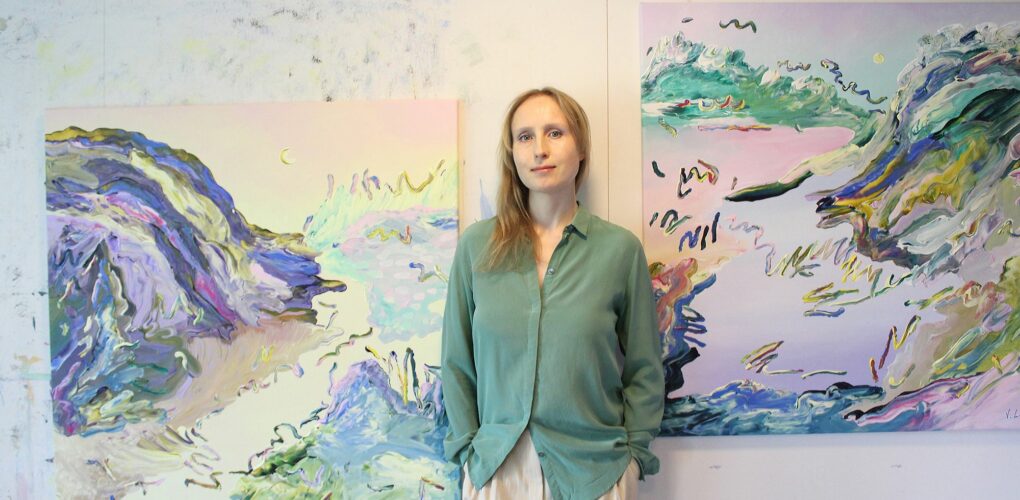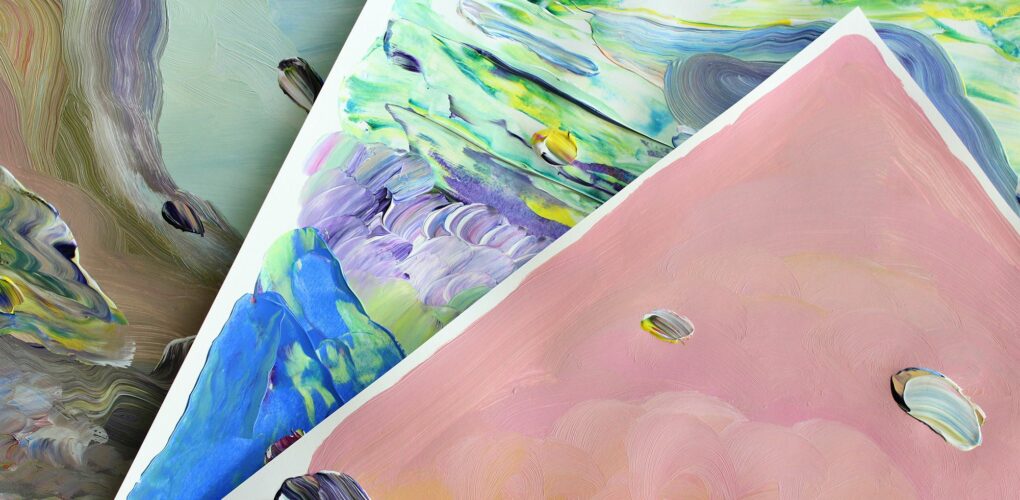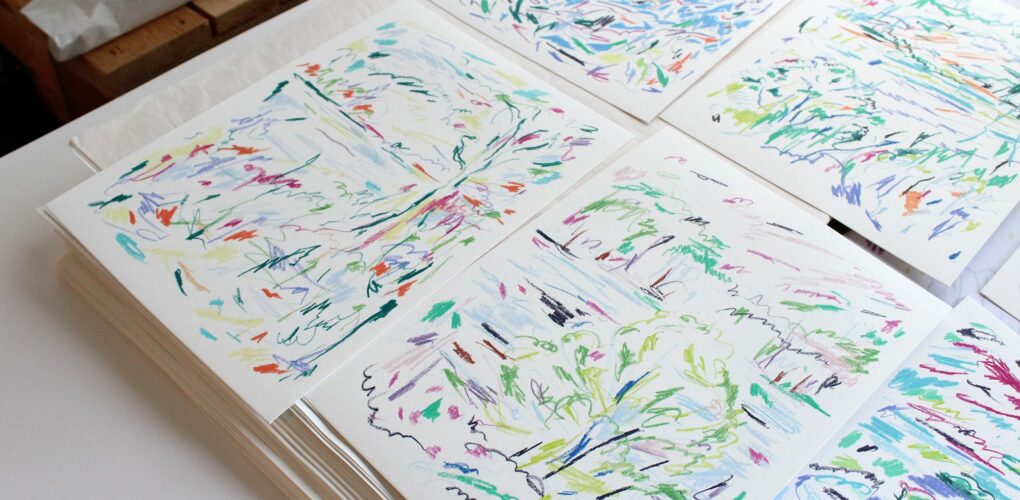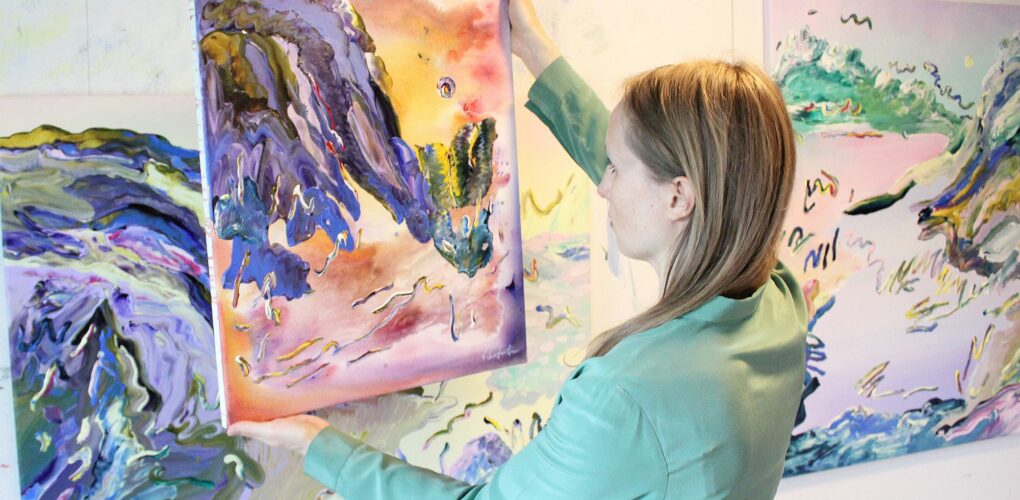One to Watch
 Exploring the Nordic Landscape: Jeanette Lafontine
Exploring the Nordic Landscape: Jeanette Lafontine
Norwegian artist Jeanette Lafontine practices mindfulness as part of the creative process for her fantastical, free-flowing landscapes. Taking inspiration from the terrain around her, Jeanette combines real places with intuitive composition to invent new environments. Since earning her MFA from the Oslo Academy of the Arts, she has exhibited extensively in Oslo and New York City. Keep reading for a look into Jeanette’s creative process, inspiration, and motivation.
Tell us about who you are and what you do. What’s your background?
My name is Jeanette Lafontine, and I am an artist based in Norway with an MFA in medium and material-based art from the Oslo Academy of the Arts. I work with paintings and drawings that most often turn out colorful and expressionistic. I have been experimenting with different materials and techniques, but most of my works are acrylic or pastel on canvas and paper. The landscape is my main source of inspiration. Even though my color palette is not limited to earthy tones, the Nordic landscape often makes itself known.
What does your work aim to say? What are the major themes you pursue in your work? Can you share an example of a work that demonstrates this?
I am not trying to visualize a specific idea or meaning through my work. I do find inspiration in the real world. Even though I paint landscapes, I am not attempting to capture something about a particular place or time. I am interested in the process of making a painting. It is a search for images. The landscape motif gives me endless combinations and variations. It feels never-ending. My paintings are a result of all the inputs, my sketches, and the process itself. I am also interested in painting both as an object and an idea. On one side you have the physical qualities of a painting: texture, color, shape, and brushstrokes. But I am also fascinated with how these different elements and shapes make a pictorial space that can trigger our imagination and bring our thoughts beyond the physical painting itself.
Can you walk us through your process for creating a work from beginning to end?
My process often begins by making a series of drawings on paper. These drawings can be rough sketches of a location or a view, or they can be intuitive sketches. Either way, they are an approximation of a specific moment, or of something half-remembered. Then I also make several paintings on paper where I randomly, and without any particular plan, add color and use different techniques to create these colorful landscapes. When moving over to the canvas these processes usually merge, where a drawing, shape, or line is applied to the canvas, and the paint becomes the material to give depth and texture to the work.
Who are your biggest influences and why?
My biggest influence is the world around me, and I can find inspiration in the change of seasons or from a walk in nature. I also find other artists’ work very inspiring, and seeing great work always pushes me to work hard. I relate to the history of painting, but discovering new contemporary artists’ work that somehow resonates with me is always inspiring.
How does your work comment on current social and political issues?
I am not deliberately trying to comment on certain issues or be political in my work, but I hope my work can be some form of escapism. Whether it makes your mind wander into a dreamy world, acts as something that gives you joy, or diverts the mind from daily struggles. In my work I also have an experimental approach to colors and form. By stretching reality, my work might feel both alien and somehow familiar at the same time. Keeping in mind the world we live in, that in itself might give my work resonance. That being said, my paintings rarely tend to look dystopic. My work can be seen as imagined worlds that have resisted human interference, and maybe that is what can make them intriguing. There is something in our DNA that is drawn to untouched nature, and yet we are not able to leave it alone and preserve it like that. We disrupt and consume. So behind all the colors, you might find a backdrop of an ambiguous man-nature relationship. Humans as an integral part, with nature being seen as a home and a provider, and on the other hand, nature as something we have had the urge to dominate.
How do you hope viewers respond to your works? What do you want them to feel?
My work relates to both abstraction and representation, and I am trying to balance between the familiar and the incomprehensible. The focus of my work is not to inform the viewer of a specific meaning or make them feel a special way. I am hoping for the viewer to see my work as something they can relate to, or just make their mind wander. I am also interested in the materiality of the paint, so the texture and tactility of the physical painting itself is also something I hope engages the viewer.
Do you prefer to work with music or in silence?
When I am working, I always prefer silence. I do not listen to music, nor do I have a radio, podcast, or TV program running in the background when I am working. When making art I am only concentrating on my work. But then again, you never see me walking around with headphones anyway. When taking a walk or even just a quick errand to the store, I always prefer to hear the sound of the places I move around in.
What was the best advice given to you as an artist?
This is not advice someone gave me, but it is something I live by when it comes to my own work: Do not have a plan B! It is difficult to be fully committed if you have a plan B to fall back on, and I need to be fully committed to being an artist.

















